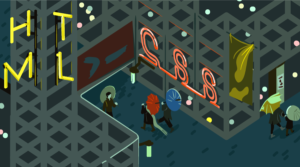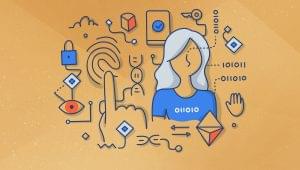Key Takeaways
- Programming languages are not ‘languages of computers’ but are designed with humans in mind. High-level languages like Python are created to be easy for humans to understand, not computers, and do not require learning to ‘speak to a computer’.
- The idea that programming languages are foreign and hard to read is a myth. Most of the time, programming languages use the same words as an existing language, often English, and their syntax is designed to be easily understood.
- Learning programming languages does not take years. The process is made easier due to the use of familiar words and syntax. There are even stories of people learning a programming language and achieving results in as little as 12 weeks.
- are the ‘languages of computers’
- are foreign and hard to read, and
- take years to learn.
Myth 1: Programming Languages are the ‘Languages of Computers’
A quick Google search reveals that people are saying things like this…How do I get fluent in Python?These people apparently think that learning a language like Python means…
- learning to ‘speak to the computer’,
- learning to ‘think like a computer’, and
- becoming ‘fluent’ in a language not ‘native’ to them.
a computer programming language that resembles natural language or mathematical notation…High-level languages resemble natural language, and use concepts like mathematics and logic, because they are designed to be easy for humans to understand, not computers. Learning one of these high-level languages doesn’t mean learning to ‘speak to a computer’. The whole reason they exist is so that we don’t have to. So if high-level languages are designed to be easy for us to understand, what does one actually look like? Continue reading to see an example…
Myth 2: Programming Languages are Foreign and Hard to Read
If you were to attempt to read some text written in a language foreign to you, you may be faced with…- a different alphabet to the one you’re familiar with,
- unfamiliar grammar rules and syntax,
- and most dauntingly, a whole new set of words you’ve never seen.
INSERT INTO Table
VALUES ('1', 'SQL', 'Programming language')
For the purpose of this example, let’s assume your primary tongue is English, and we’ll compare that to SQL.
Firstly, the alphabet is most certainly not foreign. All the characters used can be found on a standard Roman alphabet keyboard.
Secondly, look at the grammar rules and syntax. While there’s a bit of deviance, ‘insert into table’ is familiar and readable. As an English speaker, you’d have little trouble figuring out the meaning of the code.
Lastly, look at the words. Every word there is pre-existing in the English language. No foreign words, no difficult pronunciations, no scratching your head working out the meaning of each word.
Granted, programming languages do invent abbreviations – such as regex (regular expression) and varchar (variable character), just to name a few.
But at the end of the day, the full ‘lexicon’ of a programming language is derived entirely from a real-world language – whether that be English or any other tongue.
This is why programming languages aren’t languages at all. In fact, you could say programming languages are really more like dialects than languages.
Learning your first programming language now doesn’t seem so hard as learning a real-world language. And as you’ll see next, it doesn’t take as long either…
Myth 3: Programming Languages Take Years to Learn
To learn a foreign language, you need to learn…- the vocabulary (so that you have the words to express your ideas),
- the grammar (to be able to string them together into sentences), and
- the ability to read, listen, pronounce and speak.
Bottom Line…
Programming languages are easy to read, quick to learn and designed with people like you in mind. So why not make today the day you finally learn your first programming language? After all, now you have no excuses left! Do you find learning a programming language easy or hard? Share your thoughts with us in the comments. And if you enjoyed reading this post, you’ll love Learnable; the place to learn fresh skills and techniques from the masters. Members get instant access to all of SitePoint’s ebooks and interactive online courses, like HTML5 & CSS3 For the Real World. Comments on this article are closed. Have a question about learning a programming language? Why not ask it on our forums?Frequently Asked Questions (FAQs) about Learning Programming Languages
Why does learning programming seem so difficult?
Learning programming can seem daunting at first due to its abstract nature. Unlike other skills, programming requires a deep understanding of logic and problem-solving. It’s not just about memorizing facts or formulas, but about learning how to think in a new way. This can be challenging, especially if you’re new to it. However, with consistent practice and patience, you can gradually understand and master it.
How long does it take to learn a programming language?
The time it takes to learn a programming language can vary greatly depending on several factors. These include your prior experience with coding, the complexity of the language you’re learning, and the amount of time you can dedicate to learning each day. On average, it could take anywhere from a few months to a year to gain a solid understanding of a programming language.
Is it necessary to learn multiple programming languages?
While it’s not necessary to learn multiple programming languages, doing so can certainly be beneficial. Each language has its strengths and weaknesses, and different languages are often used for different types of projects. By learning multiple languages, you can become a more versatile programmer and increase your employability.
Can anyone learn to code?
Yes, anyone can learn to code. While it may be easier for some people than others, coding is a skill that can be learned with dedication and practice. It’s not about being a ‘natural’ at it, but about being willing to put in the time and effort to understand it.
What are the most common challenges when learning to code?
Some of the most common challenges when learning to code include understanding complex concepts, staying motivated, and dealing with frustration when things don’t work as expected. It’s important to remember that these challenges are a normal part of the learning process and can be overcome with persistence and patience.
How can I stay motivated while learning to code?
Staying motivated while learning to code can be challenging, especially when progress seems slow. Setting clear, achievable goals can help. It’s also important to take breaks when needed and to celebrate your successes along the way.
Is it better to learn coding online or in a classroom setting?
Both online and classroom learning have their advantages. Online learning offers flexibility and allows you to learn at your own pace. Classroom learning, on the other hand, provides more structure and the opportunity for immediate feedback and interaction with peers. The best choice depends on your personal learning style and circumstances.
What resources are available for learning programming?
There are many resources available for learning programming. These include online tutorials, coding bootcamps, textbooks, and community forums. Many of these resources are free or low-cost, making programming accessible to anyone with an internet connection.
How important is math in programming?
While math can be helpful in programming, especially in certain fields like data science or game development, it’s not a prerequisite for learning to code. Many aspects of programming involve logic and problem-solving skills rather than advanced math.
Can I get a job in programming without a degree?
Yes, it’s possible to get a job in programming without a degree. Many employers value practical experience and a portfolio of projects over formal education. However, a degree can provide a solid foundation of knowledge and may be preferred for certain positions.
 Charles Manfre
Charles ManfreCharles Manfre is the owner of CodeConquest.com.





